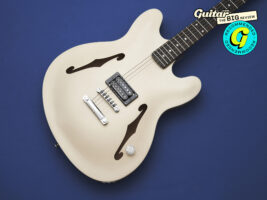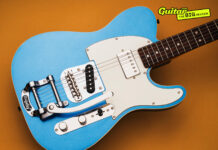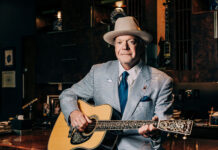
Fender Tom DeLonge Starcaster review – a stripped down rock machine that’s more versatile than it looks
$1,199/£1,149, fender.com
You might have noticed that pop-punk has been having a bit of a moment the last year or two. Whether it’s Olivia Rodrigo and Willow Smith channelling their inner emos on record, Ed Sheeran revealing himself as an Offspring superfan, or Taylor bringing Paramore on the Eras Tour, the legacy of the early 2000s mainstreaming of punk rock can be felt across the gamut of 2024 culture.
READ MORE: Line 6 HX One review – does it deserve a place on every guitarist’s pedalboard?
And then there’s Blink-182. When pop-punk’s most puerile yet tempestuous megastars got the Mark, Tom and Travis line-up back together at the tail end of 2022 the outpouring of good-will and enthusiasm took everyone – the band included – by surprise. New music and a global megadome tour soon followed, but for guitarist Tom DeLonge a new era also meant it was time for a new guitar.
DeLonge had made his name playing modded stripped-down Strats but had spent much of the previous 20 years playing similarly route-one Gibson ES-333 signature models. For his return to Blink he worked with Fender R&D man Brian Thrasher to make something that combined his entire guitar career in one unconventional instrument – the Tom DeLonge Starcaster. When Tom debuted the guitar for Blink’s last-minute Coachella spot in April 2023, the guitar internet melted down in a way that it rarely does – within weeks people were posting modded Squier and Fender instruments that were trying to emulate DeLonge’s new squeeze. Inevitably, you felt, a signature model was going to happen – and just over a year later, we have the results.
What is the Fender Tom DeLonge Starcaster?
The Starcaster is something of an ugly duckling in Fender’s history. Created to try and challenge Gibson’s dominance of the semi-hollow market in the late 70s but never caught on. The guitar was gone by the 80s but did enjoy a mini-resurgence in the 90s when it became one of Johnny Greenwood’s main Radiohead guitars. Fender launched a Chinese-made reissue in 2013, but again the response was muted, and while the guitar has carried on in the Squier range in slightly odd formats (the maple-necked active-pickup’d who-is-this-for Active Starcaster for example) it’s rarely moved the needle much.
Image: Adam Gasson
It’s not unreasonable to suspect that the overwhelming hype and enthusiasm for the DeLonge Starcaster took everyone by surprise – even Fender. The original guitars were made as a custom project for DeLonge, and Thrasher was pretty adamant at the time that they weren’t originally intended to be prototypes for a signature model.
This sense was only enhanced when Fender rushed to reissue DeLonge’s signature Strat last year – an instrument he hadn’t played for a decade but one that fans held in huge regard, and you’d imagine was dramatically more straightforward to produce on short-notice than a guitar that is totally different in construction and materials to the vast majority of Fender guitars. But the demand always made it likely that we’d see a signature Starcaster sooner rather than later, and it’s an interesting beast for sure.
What’s the difference between Tom DeLonge’s Starcaster and his signature model?
Unlike DeLonge’s other signature guitars (and pretty much all of Fender’s other non-USA signature instruments) the Starcaster is produced in Indonesia, not Fender’s Ensenada facility in Mexico.
Some might baulk at that, but it makes sense from a logistical perspective – Ensenada likely lacks the equipment needed to make a laminate-bodied semi. What’s more you’re likely going to get a better overall result contracting a build out to a facility that has a lot of experience making that type of guitar than trying to train people just for one guitar.
Beyond that, let’s consider the basics. The DeLonge Starcaster is an offset semi-hollow electric with a laminated maple body and solid maple centre-block. It features a bolt-on roasted maple neck, and like DeLonge’s custom models, it eschews the polarising ‘paddle’ headstock usually seen on Starcasters for a more conventional big 70s-style Fender peghead.
Image: Adam Gasson
The neck and headstock are roasted maple and lacquer-finished, and you also get a rosewood fretboard. Sadly, but unsurprisingly the detailed ‘smiley face’ inlays seen on DeLonge’s guitars are swapped for standard pearl dots. When you consider that the original inlays were done by former Custom Shop Principal Master Builder and inlay genius Ron Thorn, it’s easy to see why these weren’t seen as practical for the production version.
At the other end of the guitar you’ll find a familiar set-up for DeLonge guitars – a single Seymour Duncan humbucker and a single volume control is all you’ll need, though interestingly this one adds in a treble bleed circuit to stop things getting wooly as you back off the volume. There’s also a tune-o-matic bridge and adjustable tailpiece in a nod to the ES-333 guitars he played for so long.
The Tom DeLonge Starcaster comes in four classic Fender DuPont colours – Surf Green, Arctic White, Shell Pink and the Shoreline Gold example you see here. Annoyingly given the guitar’s unique proportions and pricetag, it takes a page from Gretsch’s book and doesn’t come with any kind of case.
How does the Tom DeLonge Starcaster feel to play?
The first thing that strikes me as I pull the guitar out of its box is how light it is – with its semi-hollow body and barely any electronics, the guitar tips the scales at barely 6lbs. One thing about the lack of pickups and pots in the body end is that it does feel a little neck heavy as a result, and can dip a little on the strap (something that’s likely not helped by the extra mass of those locking tuners). It’s a minor quibble though – when a guitar is this light, it hardly feels like you’re fighting it on the strap to keep it level.
Initial impressions of the build are very good – the matt finish is nicely and evenly applied all over, the bolt-on neck is solid and snug, and the neck’s glossy lacquer is smooth without being too sticky. One note on the neck – the colour of the roasted maple is significantly darker than I’ve seen in the promotional material, and has a deep chocolate hue that’s not miles away from the rosewood of the fretboard. It’s not a bad thing to my mind and actually looks nicer than the slightly orangey hue of some roasted maple, but worth being aware of if you’re buying from the internet.
Image: Adam Gasson
The modern C-shaped neck and slightly flatter than normal 12-inch radius combine for a comfortable and bend-friendly playing experience, while the 25.5” scale gives this a slightly more open and Fender-y feel than the more compact experience of a Gibson semi. The locking tuners and trusty tune-o-matic also mean that things are rock solid from top to bottom.
How does the Tom DeLonge Starcaster sound?
When I reviewed the Tom DeLonge Strat last year, despite having a tremendous amount of pop-punk fun, I had to admit that the guitar’s Seymour Duncan Invader pickup was almost comically unversatile. While it was great for pop-punk riffing, the sheer lack of tonal variety on offer made the guitar significantly less useful than you’d want a $1,300 guitar to be.
It’s interesting then, that while we still have a USA Seymour Duncan humbucker in play here, the SH-5.
And look, I’m not going to insult your intelligence by implying that this guitar is as versatile as a Strat or a 335, but combined with that treble bleed circuit it offers a genuine tonal palette rather than a giant pot of one very fun colour.
With the volume up full, it’s every bit a Tom DeLonge guitar – it’s begging you to engage your favourite distortion pedal and start chugging those powerchords and blazing through those frenetic riffs.
Image: Adam Gasson
If I were to split hairs, I’d say it doesn’t fully capture the sound of early Blink as well as the Strat did with everything jacked up – the extra resonance and air of the semi-hollow body, combined with a slightly less aggro pickup means it’s, perhaps inevitably, closer to Tom’s later Blink and Angels & Airwaves sound.
What is enjoyable however is the way the treble bleed keeps things usable as you roll the volume off – I personally found it created a better overall clean tone to ease back the volume knob to retain the clarity and warmth rather than simply turning off the dirt. There are some nice sounds in-between too, offering nice pushed cleans that give body to Going Away To College strumming or Adam’s Song single-note lines.
Is the Fender Tom DeLonge Starcaster worth it?
There’s a lot to be said for a guitar that feels genuinely unlike anything else in a brand’s range, and this is a guitar that has the potential to catch on outside of the silo of pop-punk obsessives.
It’s not the cheapest way to get a semi-hollow instrument, and it’s nowhere near as versatile as something like Epiphone’s DG-335, but there’s undoubtedly a mojo about this guitar that I find really compelling – and a price point that while not cheap, isn’t unreasonable when you compare it to similar Asian-made semi-hollow guitars.
It’s a cliche to say that a guitar is a blank canvas, but in this case that’s literally true – Tom has explained that part of the reason the guitars have such a stripped back look is because he wants people to customise their guitars, plaster it with stickers and make them unique just like Thrasher and DeLonge did with his own guitars.
Viewed through that prism, I can see this guitar having a second life outside of its target audience, as quality, leftfield Fender guitar that’s primed to be upgraded, modded and customised to make it truly your own. DIY – it’s what’s what punk is really all about.
Fender Tom DeLonge Starcaster alternatives
The Squier range has been the home of Fender’s Starcaster experiments in recent years and if you want a cut-priced modding platform that also sports the paddle headstock, the Affinity Starcaster ($299) is a real bargain. Another semi-hollow Asian-made signature model to make waves recently is the Epiphone Dave Grohl DG-335 ($1,299) which offers a huge amount of versatility for not much more money. If you’re after an affordable alternative with a bit more vintage vibe, the Guild Starfire I ($549) is well worth a look.
The post Fender Tom DeLonge Starcaster review – a stripped down rock machine that’s more versatile than it looks appeared first on Guitar.com | All Things Guitar.
Source: www.guitar-bass.net












